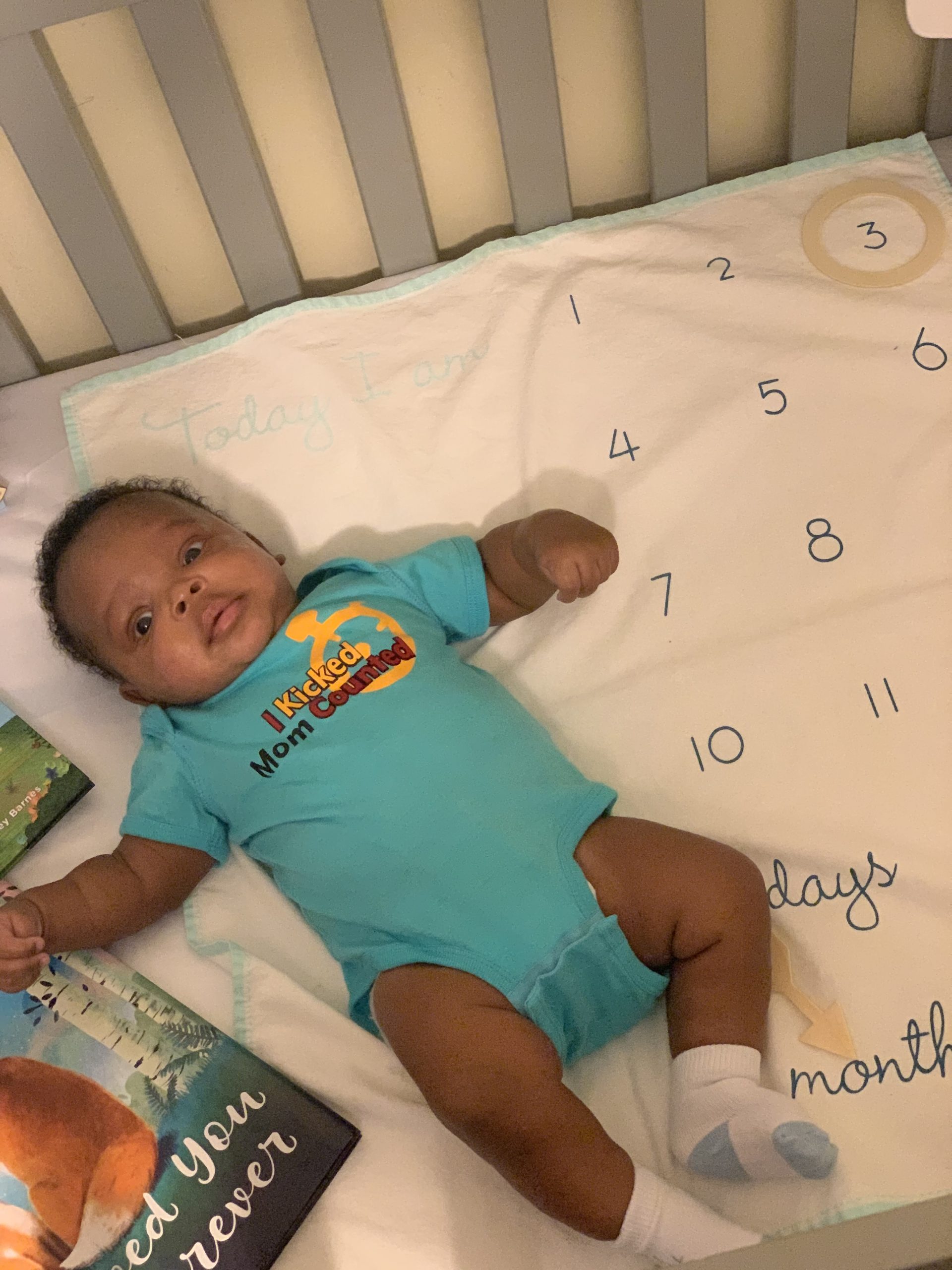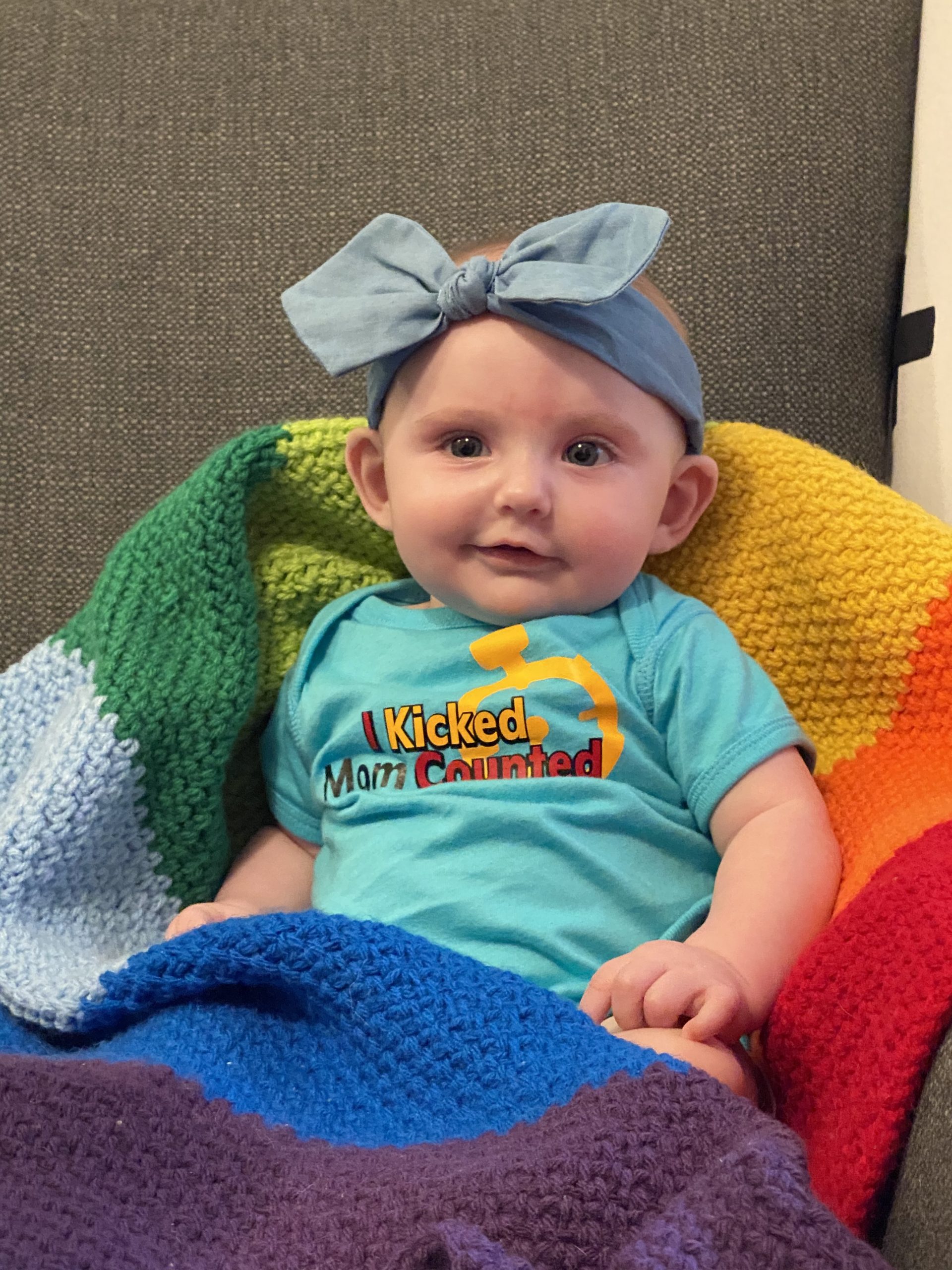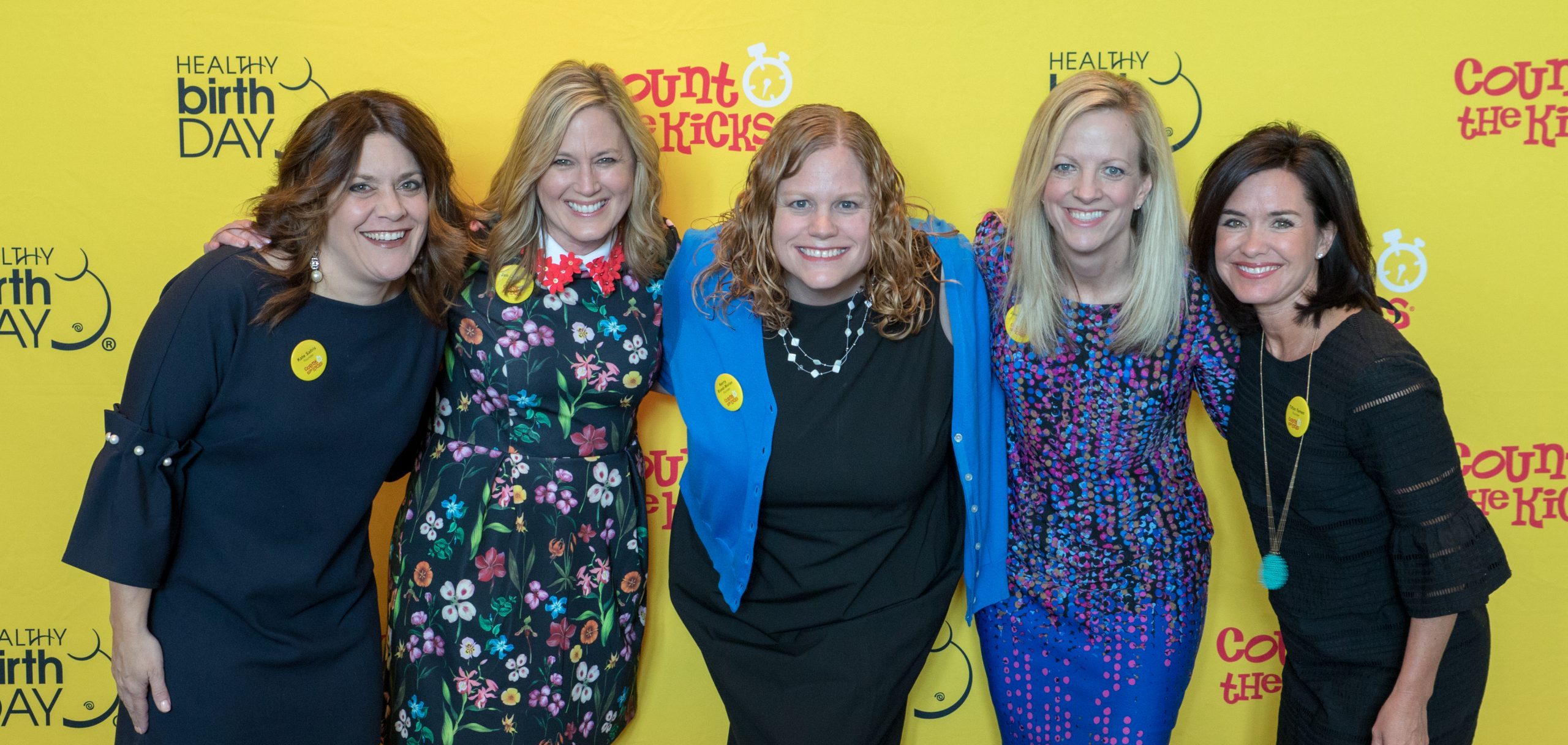
National Rainbow Baby Day: Meet our Ambassadors’ newest arrivals
Today is National Rainbow Baby Day! Have you heard the term? A rainbow baby is baby who is born into a family that has experienced a previous miscarriage, stillbirth or infant loss. The day offers a chance for families to celebrate the joy of a new baby, while reflecting and sharing about the baby they lost.
Though the Count the Kicks campaign is focused on prevention, our nonprofit organization was formed out of loss in the early 2000s after our five founders all lost daughters to stillbirth or infant death. Our founders channeled their grief into stillbirth prevention efforts in the hope of preventing other families from experiencing the pain of losing a baby. The Count the Kicks campaign started in Iowa, but the goal has always been to save babies around the country. That’s where our Count the Kicks Ambassadors come in.
This incredible group of 34 women is essential to our efforts to educate and empower expectant parents, and our Ambassador team now serves 30 states, plus Washington, D.C., Canada and India. Some of our Ambassadors join us after saving their baby through kick counting. Others find Count the Kicks only after experiencing a loss, and join the team as a way to honor the baby they lost and prevent other families from experiencing the same pain. Whatever their reason, these women are powerful advocates for kick counting, and the voice of Count the Kicks in their states.
This year we have been lucky to follow along as several of our Ambassadors prepared to welcome their Rainbow Babies, and celebrate with them as their babies arrived safely. The COVID-19 pandemic presented unique challenges for these women who were also navigating pregnancy after loss.
We asked Colorado Ambassador Candy Huffman, Ohio Ambassador DaShonda Watkins and South Carolina Ambassador Emily McConnell to share about pregnancy after loss, pregnancy during a pandemic and what having a rainbow baby means to them.
Congrats on the arrival of your Rainbow Baby! Can you tell us more about your family and your new baby?
Candy: Callie Grace was born in Aspen, Colorado, on April 20, 2020, at 4:39 p.m. She was 6 pounds, 6 ounces, and 19 inches, and was 2 weeks early because of my history with stillbirth and due to COVID. Matt and I have been together since high school (we went to Ames High in Iowa). We live in Carbondale, Colo. and both work in construction.
DaShonda: My husband is Jeremy Watkins, we’ve been married for three years. Our family consists of Jeremy, myself, our angel baby Aubrey, rainbow baby Weston and fur baby Juliette. Weston was born on April 29, 2020 at 33 weeks weighing 4 pounds, 9 ounces, and 17.75 inches long. At birth, Weston resembled his big sister, Aubrey.
Emily: My husband, Dustin, and I have been married for four years. Our first daughter, Margaret, was born still on May 10, 2019 at 37 weeks gestation. On July 1, 2020, our second daughter, Elyse, was born living. We also have a 5-year-old foster son.
-

Count the Kicks Ohio Ambassador DaShonda Watkins and her husband Jeremy welcomed their Rainbow Baby, Weston, on April 29, 2020.
How long have you been a Count the Kicks Ambassador and what does it mean to you?
Candy: I’ve been an ambassador for about three years now and it means a lot to me to spread the word about the app. I’ve talked to healthcare providers who believe in counting kicks as a way to reduce stillbirth and they’re grateful for this tool. I look forward to working on bigger things with Count the Kicks in the future.
DaShonda: I have been a Count the Kicks Ambassador since 2019. Being a Count the Kicks Ambassador means I have the opportunity to help other families have knowledge that I did not have during the pregnancy of my unfortunate baby loss. In addition, I have the opportunity to honor our daughter, Aubrey Elise Watkins.
Emily: I’ve been a Count the Kicks Ambassador for almost a year. It means the world to me that I am able to share Margaret’s story while educating women on the importance of tracking fetal movement with Count the Kicks. I want her brief life to make a difference for others. Being an ambassador has given me a chance to honor Margaret in a beautiful way.
It’s National Rainbow Baby Day! Do you use this term, and if so, what does it mean to you?
Candy: I actually don’t like the term rainbow baby. I always felt like its a nice thought, that the baby that comes after your miscarriage or stillbirth is a rainbow amidst a storm. However, I felt like my baby Ben was meant to be in my life and although I only got to hold him for 31 hours, I would trade anything to have my son with me. Ben was not a storm to be overcome by a rainbow to me, he was and is my son that I will miss for the rest of my life until I meet him again. It means everything to Matt and I that we finally have Callie. I think having her after a miscarriage and a stillbirth makes everything we do with her sweeter and more appreciated than if we hadn’t had those experiences.
DaShonda: Yes, I use the term rainbow baby! Having a rainbow baby means a promise from God, a miracle, joy after going through a storm.
Emily: Yes, I do use this term. I don’t like when the term is used as “a rainbow after the storm” because I do not think of Margaret as a storm. I like to think of rainbow babies as something beautiful and full of hope that is happening simultaneously while parents are still weathering the storm that comes from losing their precious baby.
Having a rainbow baby has given me hope, light, and joy in the midst of all the storm clouds that still hover over me. Having Elyse here with us and healthy is a dream come true. The term allows me to smile and think about Margaret with joy as well because she is a big sister.

- Count the Kicks South Carolina Ambassador Emily McConnell and her husband Dustin hold a photo of their first daughter, Margaret, who was born still in 2019.
What was your experience being pregnant after losing a baby to stillbirth?
Candy: It was definitely surreal to be pregnant. I was hopeful the whole time that it would work out but was still hesitant to tell a lot of people just in case. Then I got to 29 weeks, which is when I lost Ben the last time and it was incredibly stressful – it finally hit me that each week after 29 was a week longer than Ben lived. I think all the stress of being pregnant and hitting that milestone finally hit me. I got a terrible migraine and really struggled for a few days. I found out I was pregnant 2 weeks before grad school started so I was thankfully distracted with school while pregnant, which actually helped my stress level!
DaShonda: I intentionally waited a year after losing Aubrey, so I was mentally strong and ready when I got pregnant with Weston. When it happened it was perfect timing, and I knew it was meant to be. It came with some anxiety and “what-ifs,” but I was really embracing it. I had a maternal fetal medicine specialist this time, so the care was more hands-on and specialized for me and Weston, which gave me some reassurance. I also had more family around so I felt like I had more support. I had to continue to remind myself that this is a different pregnancy and it will have a different outcome.
Towards the third trimester, I began to have pregnancy complications. I was diagnosed with Placenta Previa and began to hemorrhage which caused delivery at 33 weeks gestation versus 36 weeks gestation as we had planned via C-section. I’m truly grateful for my medical care team that Weston and I had a positive experience and outcome.
Emily: Being pregnant after losing Margaret to stillbirth was difficult. The pregnancy was filled with anxiety and stress, even though I still enjoyed bonding with my baby. I was constantly worried that Elyse was going to die too. I was a better advocate for myself with my medical care, and always asked many questions.
You were also expecting a baby during the COVID-19 pandemic. How did that impact your pregnancy experience?
Candy: Since I’d already been through the experience of giving birth to a stillborn child, I really wasn’t as worried as most moms during the pandemic. Obviously my husband and I took every precaution to make sure neither of us got sick, but it was still not at the top of our worry list because we’ve been through a stillbirth and we really didn’t feel like anything could be worse than that outcome.
DaShonda: COVID-19 impacted the second half of my pregnancy beginning in March. Due to the spread of the virus, I stayed home with the exception of doctor’s appointments. Then I had to stay in the hospital due to complications of my placenta. Family and friends were able to visit when I first got hospitalized, but as the virus continued to spread, hospitals began to not allow visitors, so I spent weeks in the hospital with no visitors. Once we delivered and I was discharged, going back to the hospital and the NICU, we had to take all these precautions like wearing a mask. So Weston didn’t get to see our faces until we came home and took off our masks.
Emily: Expecting Elyse during the pandemic impacted my pregnancy experience because my husband was no longer allowed to come to appointments with me. I found out Margaret didn’t have a heartbeat at a doctor’s appointment alone, so I did not want to attend any doctor appointments alone. But I had to. The pandemic definitely added to my stress and anxiety, and I did not go anywhere besides the doctor’s office.
-

Count the Kicks Colorado Ambassador Candy Huffman and her husband welcomed their Rainbow Baby, Callie, on April 20, 2020.
How did you use Count the Kicks during your pregnancy?
Candy: I used the Count the Kicks app during this pregnancy and it did give me peace of mind that Callie was OK. She wasn’t a consistent kicker like Ben was, so it was a challenge to find a similar time of the day she would kick. I did not experience a change in fetal movement this pregnancy, but I also went to the doctor’s office to have a non-stress test and ultrasound weekly after 30 weeks, just to be safe. My doctor told me to come in anytime I felt any kind of discomfort or stress about the baby so I could have peace of mind; just knowing I had their support was huge.
DaShonda: Having the awareness of Count the Kicks and just knowing that stillbirth existed was important. I began using the Count the Kicks app during the third trimester of pregnancy. It took a while to get to know what was normal, but it was reassuring to tap on the foot each time. I would do it after meals in the morning and in the evening. Doing it twice a day was helpful for me, and I felt like I was doing my part in ensuring that he was still active.
In fact, on Feb. 29, when I began to bleed, after eating something I started to count my kicks to reassure myself Weston was active. Then I proceeded to call my provider and they had me come to the hospital to be seen. At that point, I was admitted and my hospitalizations were on and off until delivery. Even in the hospital I would use the app, although I had two non-stress tests daily and weekly biophysical profiles.
Emily: I used Count the Kicks during my pregnancy by using the app for my iPhone. I counted kicks every night starting at 28 weeks. Counting kicks did help give me peace of mind because my husband and I would count together and feel Elyse kicking and moving around. Normally, it took her between 4-6 minutes to get her 10 kicks. There were a couple times when I experienced a change in her movement because it took her closer to 20 minutes to get in her 10 kicks. My husband and I went to the hospital when this happened and were sent to labor and delivery for a non-stress test and biophysical profile. Every time we went Elyse was perfectly healthy.
What is your favorite feature of the Count the Kicks app?
Candy: I like that it tracks the history of your kicks so you can look back and see how your baby’s activity has (or hasn’t, in my case) changed. I no longer worried about if she was kicking the same day-to-day because the app “remembered” for me.
DaShonda: I felt very empowered, informed, educated and bonded to Weston each time I used the app. I found that doing it twice a day was helpful, after breakfast and later towards the evening/night. The reminders were helpful for when I missed a day or time as well. I do credit having the knowledge of counting the kicks to be very purposeful in how I handled my initial bleeding as a result of another type of complication, placenta previa. As a high-risk mom, Count the Kicks has truly been a blessing in our lives and part of the reason Weston has a Healthy Birth Day!
Emily: My favorite feature of the app was the graph that showed all the previous data from previous kick sessions. It was helpful to be able to compare each kick session.
What do you want expectant parents to know about stillbirth, pregnancy after loss, and the Count the Kicks campaign?
Candy: I want other moms to know that going through the experience of stillbirth should not be happening in the U.S. in 2020, but it does and that this simple Count the Kicks app can prevent it! That’s it! It’s an app and 10 minutes or so out of your day. I know it’s not fun to think about stillbirth, but pregnancy is scary and a lot of bad things can happen — why not let the Count the Kicks app manage one of those big concerns for you?
DaShonda: I want other mothers to have awareness of stillbirth. If you don’t know about something, you aren’t attune with it. Every pregnancy is different. I want other moms to know they can have a healthy birth day after going through an unfortunate loss. I want other moms to feel empowered knowing they have a tool with the Count the Kicks campaign and they are their baby’s best advocate. Lastly, if they notice any changes to follow their motherly instincts.
Emily: Margaret’s death has been the most devastating experience of my life, and her death is unexplained. She falls into the category where 60 percent of stillbirths are unexplained.I was never educated on the importance of keeping track of fetal movement during the third trimester, but I strongly believe that if I had been, Margaret would be here with us today. Counting kicks allows you to have knowledge of your baby’s movements and is a fantastic way to bond with him/her.
What do you hope to accomplish in your role as a Count the Kicks Ambassador in your state?
Candy: I would like to start a stillbirth registry in the state of Colorado so we can track the data. What we ultimately need in the U.S. is a nation-wide registry; starting one in my state is just one step to getting there.
DaShonda: As a Count the Kicks Ambassador, I hope to provide awareness throughout the state of Ohio as about the Count the Kicks campaign. I welcome collaboration with partners in the state of Ohio. I desire to see data that supports the decrease in stillbirth rates occurring in Ohio, resulting in more babies saved!
Emily: We are currently working towards state funding for Count the Kicks in South Carolina. This means that medical professionals would be able to order Count the Kicks materials for free in order to share them with their patients in an effort to decrease the stillbirth rate here in South Carolina. We currently have materials available for free to medical professionals in the Charleston area due to the funds raised from our “Walk of Remembrance: Miles for Margaret, Lydia, and All Babies Gone Too Soon” held in October of 2019.
Easy Delivery!
Sign up for our newsletter for the simplest way to stay in touch with the latest information about our mission, events, volunteer opportunities, and more.



